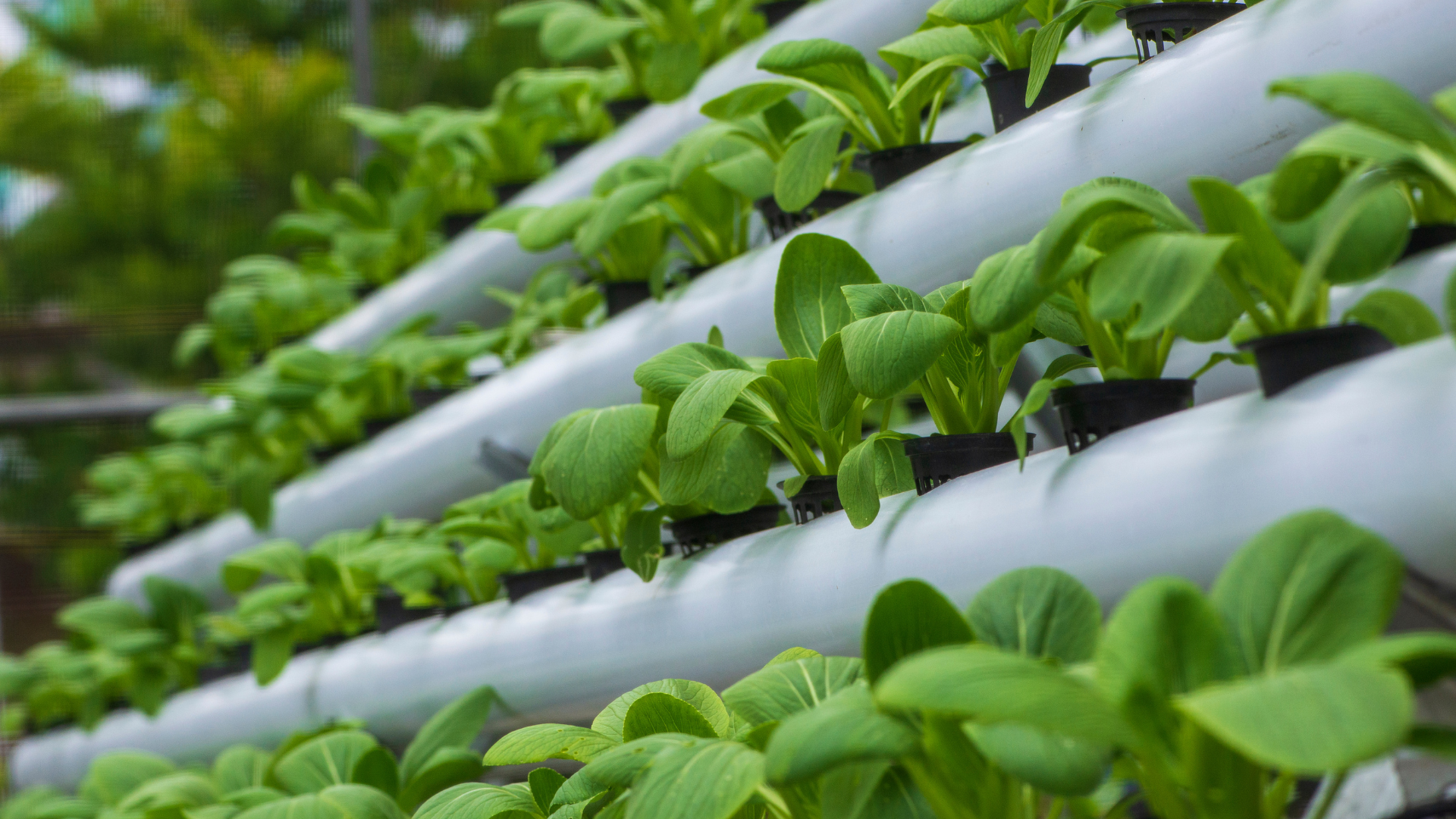An Overview of Vertical Farming
Advertisement
Introduction
Conventional agriculture has long been dependent on the use of farmland, natural sunlight, water, and favorable weather conditions. However, as climate change continues to disrupt weather patterns and reduce viable farmland, innovative solutions like vertical farming are emerging as potential alternatives.
What is Vertical Farming?
Vertical farming is a relatively new method of growing crops in vertically stacked layers, often within heavily controlled indoor environments. This approach can use hydroponics, aeroponics, or aquaponics - methods that all use nutrient-rich water, instead of soil, to grow plants. With hydroponic systems plant roots are submersed in nutrient rich liquid. With aeroponic systems roots are suspended in the air. Aquaponic systems involve the production of fish, often Tilapea, hosted underneath the plants.
Traditional farming can be highly susceptible to droughts, floods, and other climate-related disasters, whereas vertical farming provides a consistent and controlled environment where crops can thrive year-round, even in external climates that are too cold, such as the far north or too hot like the middle east.
Currently, the most commonly grown crops in vertical farms are leafy greens such as spinach, lettuce, kale, herbs, and microgreens. These crops are well-suited for vertical farming because they require relatively little space, grow quickly, and yield high nutritional value. Aquaponic fish species include tilapia, catfish, goldfish, koi. These fish are chosen due to growth rate of the fish, reproductive habits, diet, and more
Vertical farming is one growing tool in building resilience against climate change and ensuring food security for urban populations. The global vertical farming market was valued at $4.8 billion USD in 2022 and is projected to grow significantly, reaching an estimated $33 billion USD by 2030. In Canada, the industry is also experiencing rapid expansion, with Bonafide Research forecasting a 20.93% growth by 2027.
A vertical farm in Indonesia, farming lettuce using hydroponics.
The Benefits of Vertical Farming
Vertical farming presents several advantages over conventional agriculture, particularly in a world where farmland and resources are becoming increasingly scarce, and weather is becoming more extreme.
Efficient Land Use
Vertical farms require significantly less land than traditional farms. In fact, one acre of vertical farming can yield the same amount of produce as 10 to 20 acres of open-field farming. In urban settings, vertical farms can be integrated into existing buildings, abandoned warehouses, or even reused shipping containers, making it possible to grow food closer to consumers and reducing transportation emissions.
Advertisement
Year-Round Crop Production
Unlike traditional farming, vertical farming allows for year-round crop production. This is especially beneficial in regions where harsh climates make conventional farming nearly impossible. Fresh produce can be grown and harvested throughout the year, reducing dependency on imports and ensuring a stable food supply.
Reduced Water Consumption
Agriculture is one of the largest consumers of freshwater, but vertical farming significantly reduces water usage. Compared to traditional farming methods, vertical farms use up to 95% less water. Advanced irrigation techniques minimize waste and allow for water recycling.
Pesticide-Free and Safer Food Production
Because vertical farming occurs in a controlled indoor environment, there is no need for chemical pesticides, herbicides, or fungicides. This reduces the risk of harmful residues on produce and decreases the chances of contamination from pathogens such as E. coli, which are more common in traditional farms which occasionally recall produce at risk of contamination.
Urban Integration
Vertical farming is able to provide fresh produce to urban communities by bringing food production closer to consumers. This minimizes transportation costs, reduces food waste, and provides fresh, locally grown produce to cities. In countries that are colder, such as Canada, this can discourage the import of food by growing produce closer to local communities.
The Challenges of Vertical Farming
Despite its many benefits, vertical farming also has several challenges that need to be addressed for it to be widely adopted.
High Energy Costs
One of the biggest drawbacks of vertical farming is the reliance on artificial lighting and climate control systems. Unlike traditional farms that use free solar energy, vertical farms must replicate sunlight using LED lights. Additionally, maintaining proper humidity, temperature, and air circulation can be costly and energy-intensive. Depending on the energy source, this can contribute to a high carbon footprint unless renewable energy is integrated into the system. Advances in lighting technology promise to reduce the high energy costs of vertical farming. Sourcing trained human resources is another challenge for vertical farms.
Advertisement
Initial Investment and Operational Costs
Setting up a vertical farm requires significant capital investment in infrastructure, technology, and automation. High-tech equipment such as hydroponic systems, automated nutrient delivery, and climate control systems add to the overall costs. While operational costs may decrease over time due to improved efficiency, the initial investment remains a barrier for many vertical farmers.
Crop Limitations
Currently, vertical farming is best suited for leafy greens and herbs which have a high market value. Important staple crops such as wheat, corn, and rice that underpin our food security require larger spaces and are less economically viable in a vertical farming setting. However, advancements in agricultural technology may allow for the expansion of crop varieties in the future. Some vertical farms have started growing rice, tomatoes, and different varieties of fruits and vegetables.
Case Studies in Vertical Farming
Canada: GoodLeaf Farms
GoodLeaf Farms, based in Guelph, Ontario, is one of Canada’s leading vertical farming companies. The company aims to reduce Canada’s reliance on imported leafy greens, which currently make up over 90% of the country’s supply. By growing produce in a controlled environment, GoodLeaf’s vertical farms can produce as much lettuce on one acre as traditional farms would need 350 acres for. Additionally, their operations generate about 50% less carbon emissions compared to open-air farms.
Tomatoes being grown in a vertical farm, in a greenhouse.
Iceland: Tomato Farming in Harsh Climates
Fridheimar is a family business that grows tomatoes in a greenhouse using hydroponics, allowing them to grow fresh produce despite its cold climate. The controlled environment ensures that several species of tomatoes are available year-round without reliance on imported goods, enhancing local food security. They use 100% renewable energy to power their greenhouses, allowing for an even more sustainable approach to vertical farming.
Singapore: Vertical Rice Farming
Singapore, a country with limited arable land, has embraced vertical farming as a means of achieving food security. Netatech, a Singaporean company, has pioneered vertical rice farming using precision drip irrigation. This method reduces water usage significantly, from 2,500 liters per kilogram of rice in traditional paddy fields to just 750 liters. This is the start to growing cereals in vertical farms, and shows the ability to branch out to different types of crops.
The Future of Vertical Farming
Vertical farming is not just limited to Earth - it may play a crucial role in space exploration. As scientists explore the possibilities of long-term space missions, vertical farming provides a sustainable method for growing food in space stations or Mars habitats. NASA and private space organizations are actively researching how to integrate hydroponic and aeroponic farming into space missions.
Conclusion
Vertical farming is one of many promising solutions to build climate resilience and address some of the challenges faced by modern agriculture. By producing fresh, pesticide-free food in controlled environments, vertical farming reduces land and water use while increasing food security. However, challenges such as high energy costs and limited crop diversity must be addressed for it to become a mainstream agricultural practice.
As technology continues to advance and governments invest in sustainable or alternative agriculture, vertical farming will likely play an increasingly important role in feeding future generations.
Advertisement
Rushil Malik is the Marketing Manager at Green Roofs for Healthy Cities.






